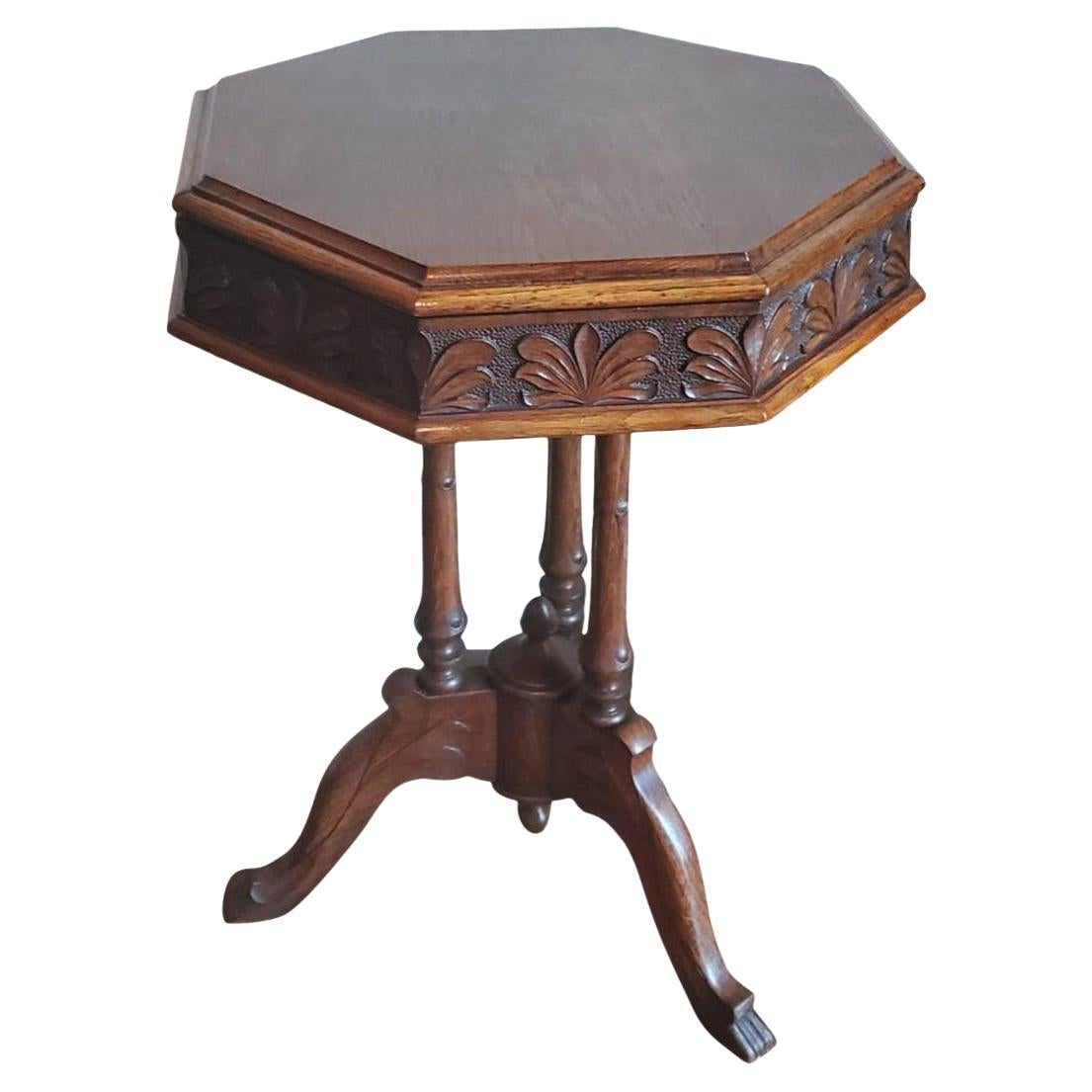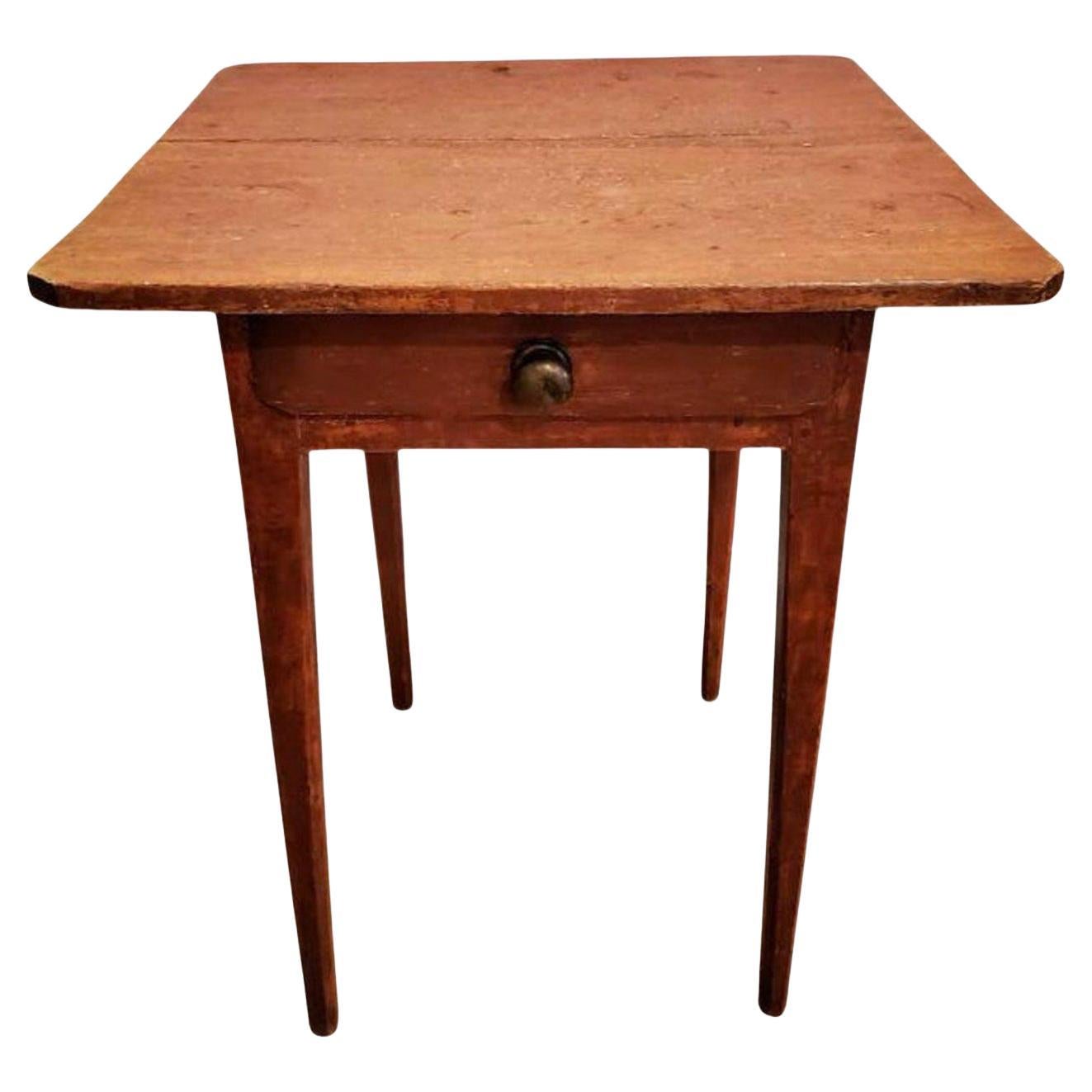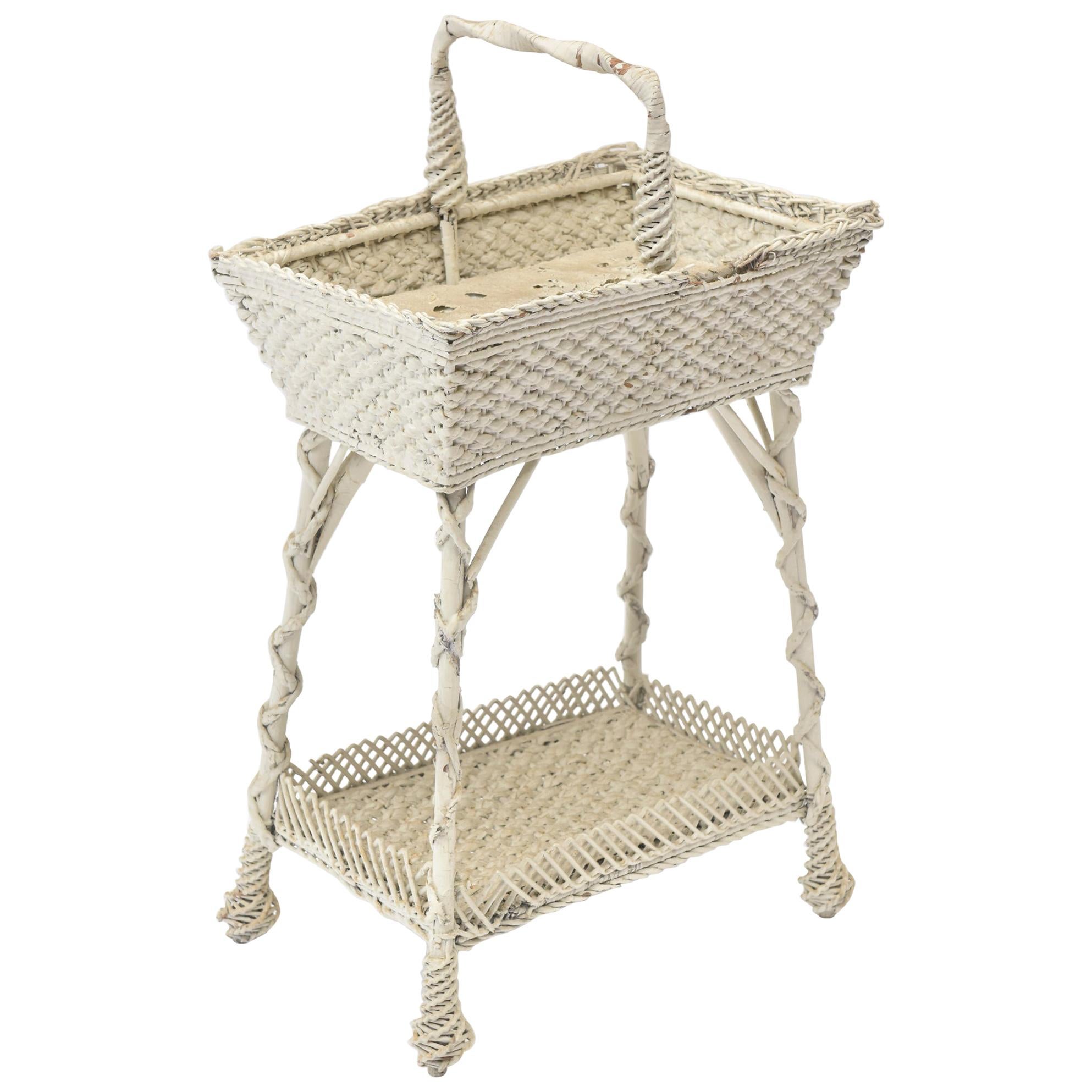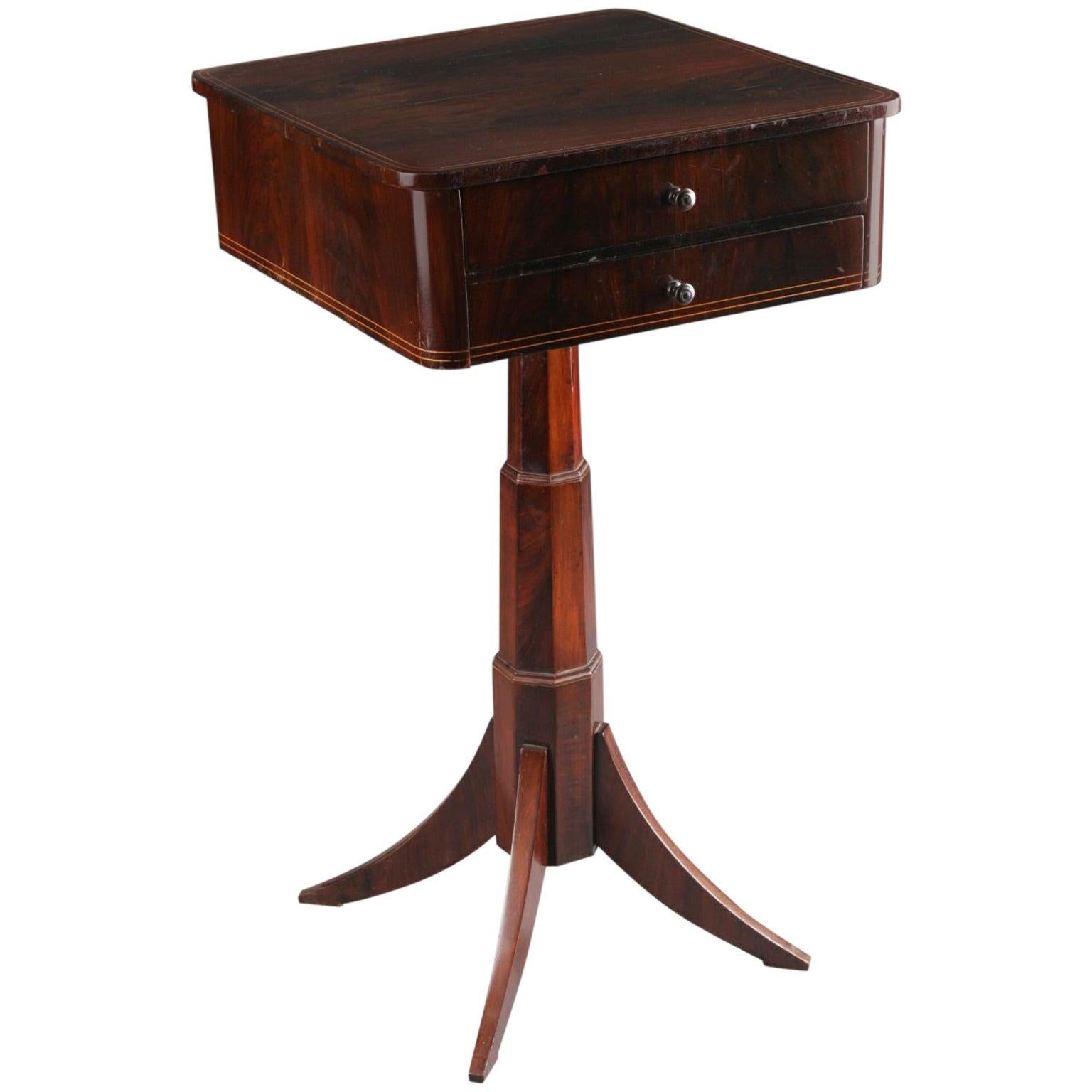Items Similar to Early 19th Century American Classical Sewing Stand
Want more images or videos?
Request additional images or videos from the seller
1 of 9
Early 19th Century American Classical Sewing Stand
About the Item
A fine and rare, beautifully restored American Classical period sewing stand work table in mahogany and rosewood.
Elegantly sophisticated, this scarce antique is a wonderful example of high quality early 19th century American craftsmanship. Exhibiting fine detail throughout, the exquisitely handcrafted work table features a hinged shaped top with rounded corners, curved concave front, stunning highly figured matched rosewood inlay complimented by mahogany cross banded edge, set over a conforming shaped case. Lifting the top opens to reveal a fitted interior divided into eight compartments, including a hinged lid with built-in flip-up pin cushion, various size shaped lids are finished in mahogany accented by contrasting satinwood string banded border, a faux drawer front with contrasting mother-of-pearl escutcheon rests above a single frieze drawer with hand carved dovetail joinery and original turned wooden pull. Below, a perfectly proportioned carved, turned and fluted solid mahogany central pedestal rises from a shaped platform base, in true Empire fashion, the base is further raised on ornately carved paw feet.
Beautiful, rich antique mahogany color and tone, extraordinary wood grain patterns with soft, warm elegantly aged patina.
A versatile piece with the ideal proportions for use as a side table, accent table, lamp stand, bedside nightstand, hall table and many others.
Dimensions (approx):
31.25" high, 22.5" wide, 17" deep
Great antique condition
Moderately restored, retaining some character, delivered cleaned, waxed, polished and ready for many more years of use.
- Dimensions:Height: 31.25 in (79.38 cm)Width: 22.5 in (57.15 cm)Depth: 17 in (43.18 cm)
- Style:American Classical (In the Style Of)
- Materials and Techniques:
- Period:
- Date of Manufacture:Early 19th Century
- Condition:Wear consistent with age and use.
- Seller Location:Forney, TX
- Reference Number:1stDibs: LU5977226965422
About the Seller
4.8
Platinum Seller
These expertly vetted sellers are 1stDibs' most experienced sellers and are rated highest by our customers.
Established in 2013
1stDibs seller since 2021
197 sales on 1stDibs
Typical response time: <1 hour
- ShippingRetrieving quote...Ships From: Forney, TX
- Return PolicyA return for this item may be initiated within 7 days of delivery.
More From This SellerView All
- Mid 19th Century English Victorian Octagon Sewing TableLocated in Forney, TXAn English Victorian carved oak sewing table from the mid 19th century. Having an octagonal hinged top with foliate carved border, opening to fitted compartmentalized interior, divid...Category
Antique Mid-19th Century Victorian Industrial and Work Tables
MaterialsFabric, Oak
- Primitive 19th Century American Farm Work TableLocated in Forney, TXPrimitive perfection!! A charming antique American pine country farmhouse work table in original red paint. Hand-crafted in the early 19th century, originating in the northeastern Un...Category
Antique Early 19th Century American Country Industrial and Work Tables
MaterialsPine, Paint
- Early 19th Century American Farmhouse Harvest Work TableLocated in Forney, TXAn early American country farmhouse double pine board harvest table with beautifully aged patina. circa 1800-1810 Born in the Northeastern United States in the early 19th century ...Category
Antique Early 19th Century American Primitive Industrial and Work Tables
MaterialsPine, Paint
- Antique English Edwardian Marquetry Inlaid Sewing TableLocated in Forney, TXA fine quality Edwardian period sewing work table, exquisitely handcrafted in England at the turn of the 19th / 20th century. The extraordinary table features exceptional attenti...Category
Early 20th Century English Edwardian End Tables
MaterialsBirdseye Maple, Ebony, Mahogany, Rosewood, Satinwood
- Early 19th Century American Primitve Texas Farmhouse Painted Pine Work TableLocated in Forney, TXA scarce Texas farm house painted pine work table with dark rich nicely aged distressed patina. Hand-crafted by a skilled but formally untrained farmer i...Category
Antique Early 19th Century American Country Industrial and Work Tables
MaterialsPine, Paint
- 19th C. French Charles X Restoration Period Sewing Stand Work TableLocated in Forney, TXA scarce period Charles X (1818-1834) French Restoration mahogany travailleuse sewing (thread stand - side table - jewelry dressing table) with light, warm, beautifully aged patina. Born in France in the early 19th century, almost certainly Parisian work, exquisitely hand-crafted, this exceptionally executed example features ornate gilt bronze ormolu mounts, escutcheons, and elaborate gilt metal trim. Having a highly figured light mahogany hinged lid top, lifting open to reveal a striking finished interior with divided compartments and original inset mirror plate. The conforming rectangular case fitted with a faux drawer front over a dovetailed drawer with sectioned interior. Elegantly rising on oval-shaped medial shelf stretcher-joined curvacious legs. Dimensions (approx): 27" High, 20" Wide, 13.5" Deep Stunning light almost blonde antique mahogany coloring and mellow warm tone, superb wood grain detail, and charming, beautifully aged patina over the whole. Great shape overall. Retaining original antique character marks, wear consistent with age and indicative of minimal use, nothing that detracts from the aesthetics or functionality, but only adds to the overall authenticity, refined elegant warmth, luxurious sophistication, and cozy unpretentious rustic elegance. Delivered cleaned, hand waxed, polished French patina finish, ready for immediate use and generational enjoyment! What is Charles X style: The comte d’Artois – or Charles X - was the son of the dauphin Louis-Ferdinand de Franc and Marie-Josèphe de Saxe. He succeeded his two brothers Louis XVI and Louis XVIII and became the King of France in 1824. Thirty years after the French Revolution, he wanted to embody the return of monarchy and became the leader of the catholic party . As the previous kings, he was crowned in 1825 but he was soon overthrown by the revolution in July, 1830, called "Trois Glorieuses". He left then for England, Scotland, Prague and Istria where he died in 1836. Charles X style lasted from 1818 to 1834 and happened during the Bourbon Restoration (French Restoration). This style did not replace totally the style of furniture from the French Empire but it was different from the formalism in the Napoleonic era, during which strictness and simplicity were inspired by Greco-Roman art. Indeed, artistic fields flourished. In terms of furniture, this renewal was suggested by the softening of shapes. Even though the simple aspect from the French Empire was still visible, shapes became curvier with volutes and arabesques. Another distinction is the loss of the massive aspect of furniture and the decrease of dimensions in order to decorate smaller appartments. Handling ability and comfort were key-words in the making of furniture. Apartments had essential elements such as chests of drawers, big rounded tables in the dining room, desks or secretaries, armoires and even dressing tables, comfortable fainting couches in the living room, small tables, pedestal tables, as well as gondola chairs. The wavy aspect of the latters certainly represent Charles X style the best. One of the most emblematic features of this style is the use of bois clairs – light woods in warm blond tones - and indigenous woods that are varnished in order to highlight the grains. Bird's-eye maple, ash trees, plane trees, yew trees, beech trees, olive trees and cedar trees were most likely to be used. Indeed, at the beginning of the 19th century dark woods were hard to find. In 1806, the Napoleon’s Continental System was established in order to ruin the United Kingdom by preventing the country from any business with the rest of Europe. Therefore craftsmen had to find alternatives from mahogany which was the most commonly used material at this time. After 1815, the import of wood was even more difficult because of peace treaties and the European political situation, which contributed to the popularity of the bois clairs and indigenous woods. The furniture was often decorated with fine inlays made out of dark wood representing foliage, which contrasted with the veneer. Even though these patterns can look like bronze decorations from the Empire era, they were far more simple and did not represent any military or mythological attributes. On the tables, trays were sometimes made out of marble as in the French Empire, but it was often put aside and inlaid veneer, Verre Eglomisé – a type of glass with a mirror finish –, mirror or porcelain from Sèvres or Paris were more likely to be used. Decorative elements from the Monarchy were highly appreciated again as they suggested luxury. Indeed, marquetry work was particularly fashionable - Boulle marquetry thrived around 1820 as the works of the Levasseur family can show. In the same way, draperies and trimmings referred to the monarchist splendour. Fabrics were often white – the traditional colour of the Bourbons – or light coloured as oppposed to the typical green from the Napoleonic era. One of the most symbolic figures from this period of time might be Jean-Jacques Werner (1791-1849), a cabinetmaker who worked for prestigious clients such as the Duchesse de Berry who was Charles’s step-daughter. His works can be seen at the Musée des Arts Décoratifs and at the Grand Trianon in the Palace of Versailles. The duchess’s appartments situated at the pavillon de Marsan and at the Palais de Saint Cloud illustrate Charles X style the best with furniture made out of bois clairs and ornamented with dark wood patterns or fine gold decorations. Chales X style allows a transition between the sobriety of the Empire style and the abundant aspect of Louis-Philippe style. The gothic style started at this time through the "style à la cathédrale", inspired by religious architecture, which thrived from 1827 to 1830. Indeed, at the beginning of the 19th century, Romanticism put the spotlight on the Middle Ages. Cabinetmakers were not inspired by the medieval furniture but rather by architectural elements of churches and cathedrals. For instance the backs of chairs were decorated with arches shaped like rib and serration. In the same way, before Charles X abdicated, pieces of furniture were made out of dark woods – such as mahogany, which was used again in France – and were inlaid with light wood. Romanticism also influenced the layout of furniture in appartments to suggest movement through a mix of various styles, various shapes and various sizes, as opposed to the static aspect of Neoclassicism. The start of industrialisation and mechanisation also influenced this style as early technical developments led to the production of pieces of furniture in series. Credit: Marc Maison Bibliography: FANIEL Stéphane (Dir.), Le Dix-neuvième Siècle Français, Collection Connaissance des Arts, 1957, Hachette SASSONE, Adriana Boidi, Furniture from Rococo to Art Deco, 2000, Evergreen -- Extremely versatile: As warm and attractive as it is useful, this remarkable antique table having the ideal size and small proportions for a variety of different uses, including as a side table, accent or occasional table, tall sofa...Category
Antique Early 19th Century French Charles X End Tables
MaterialsBronze, Ormolu
You May Also Like
- Early 19th Century Irish Regency Burr Elm Work TableLocated in New York, NYThe molded rectangular hinged top supported over molded case opening to reveal fitted compartmental interior including two fitted spools, raised over shaped corner brackets supported...Category
Antique 1820s Irish Regency Industrial and Work Tables
MaterialsElm
- Early 20th Century Wicker Sewing StandLocated in Miami Beach, FLPart of a large collection of ornate wicker that was collected over the years by a Senator's wife. Early 20th century, the open sewing basket has a woven...Category
Early 20th Century American Industrial and Work Tables
MaterialsWicker
- 19th Century English Black Japanned Work TableLocated in New York, NYWith gilt chinoiserie decoration of court figures in a mountainous landscape on a black ground; the hinged rectangular top with canted corner opening to a paper-lined interior; raise...Category
Antique Mid-18th Century English Sheraton End Tables
MaterialsWood
- 19th Century Biedermeier Sewing TableLocated in Opole, PL19th-Century Biedermeier Sewing Table Veneered With Mahogany We present you a sewing table from the 2nd half of the 19th century. The form of this piece of furniture is modest – cha...Category
Antique Late 19th Century European Biedermeier Industrial and Work Tables
MaterialsMahogany
- 19th Century Biedermeier Sewing TableLocated in Berlin, DEDecent Biedermeier sewing table, circa 1825. Mahogany on solid softwood. Straight, two-handed frame box on a telescopic column on saber-shape...Category
Antique 19th Century European Biedermeier Industrial and Work Tables
MaterialsWood, Mahogany, Softwood
- 19th Century Biedermeier Sewing TableLocated in Berlin, DEHighly interesting Biedermeier sewing table, circa 1820. Mahogany on solid beechwood. On strongly curved cross-legged legs, joined by a slightly in...Category
Antique 19th Century Biedermeier Industrial and Work Tables
MaterialsWood, Beech, Mahogany
Recently Viewed
View AllMore Ways To Browse
Antique Wood Work
Wooden Industrial
Antique Work Table 19th Century
Antique Wood Work Table
Wood Carved Work Table
Antique Sewing
Antique Sewing Sewing
Antique Sewing Furniture
19th Century Bedside Table
Round Industrial Table
Early American Wood Tables
Open Work Band
Bedside Work Table
Antique American Work Table
Early American Side Table
Antique Mahogany Work Table
Pin Cushion
Classical Round Table





